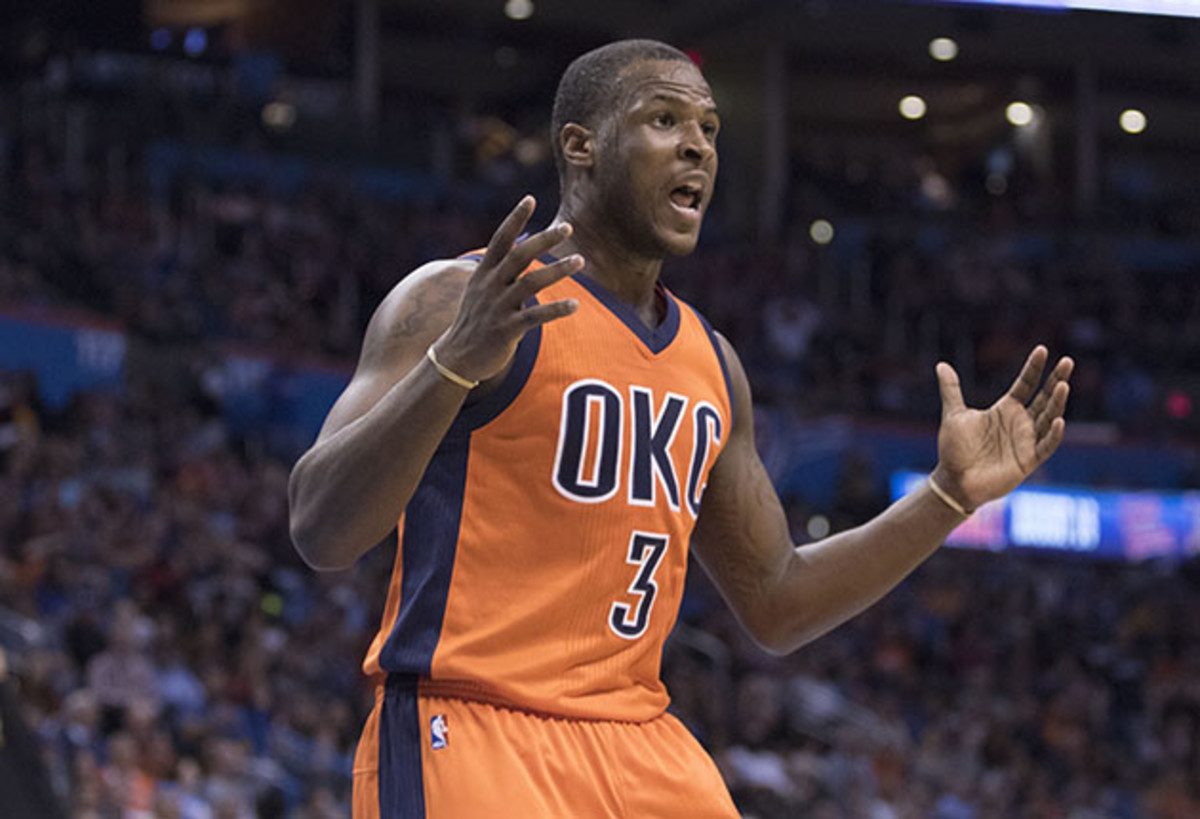Shoot and miss: Thunder wing issues don't end with Dion Waiters

Imagine you’re Oklahoma City Thunder head coach Billy Donovan. In your first NBA season, your team is 42–19 and sitting comfortably in third place in the Western Conference. You’ve rebounded from a rocky start and staked your rightful place among the best teams in the league. You have a top 2 offense and a borderline top 10 defense. You, personally, have a stern visage and impeccable salt-and-pepper hair. Everything is pretty good, Wednesday's collapse against the Clippers notwithstanding.
Now, imagine you’re about to head into the final minutes of a close game. You know you want Kevin Durant, Russell Westbrook and Serge Ibaka on the floor, as always. You’re probably rolling Steven Adams out there, too, unless you’re playing against (a) the Warriors’ death lineup (in which case you probably have to go small), or (b) some team with a big man bad enough offensively that it allows you to get away with playing Enes Kanter (Note: This is extremely rare).
Joy ride: On the road with the Warriors
But how about that last spot, between Westbrook and Durant, at shooting guard? You scan down the bench and see the following faces looking back at you: Andre Roberson, Dion Waiters, Kyle Singler, Randy Foye, Cameron Payne and Anthony Morrow. There’s not a single two-way player in the bunch. Defenses pretend Roberson doesn’t exist. Morrow pretends defense doesn’t exist. The good Kyle Singler actually ceased to exist when your team traded for him at last year’s deadline. Foye hasn’t shot well for over two years and doesn’t have the size to match up with bigger off-guards. Payne has played pretty well in limited minutes this season, but he’s small and slight and a rookie and doesn’t have that much experience playing off the ball.
And so, pretty much by default, you’re left with Dion Waiters. The guy who carried a 49.5 true shooting percentage for two and a half years in Cleveland and has somehow shot even worse in OKC despite taking a sharp decrease in usage (which typically, if ideally, brings an increase in efficiency) and, yanno, playing with Kevin Durant and Russell Westbrook. The guy who, in a little more than a year with your team, is 12-of-33 from the field and 3-of-16 from three in crunch time. The guy who has carried a “he’ll be a good defender some day” reputation because of his size and strength and length (and the fact that he was the fourth pick in the draft) despite there being little evidence—on tape or in any existing metrics—that he has played even average defense at any point in his NBA career. In his career, Waiters has typically been one of the more Vineable (in a bad way) defenders in the league. This guy:
I don’t say all this to pick on Dion. It’s not his fault the Thunder don’t have any better options to turn to. They’ve yet to find a replacement for the James Harden trade four years ago, and Waiters really is the closest thing they’ve had to a two-way player. Kevin Martin was a good shooter and a terrible defender. Thabo Sefolosha was a terrific defender and a pretty good shooter, but it took him so long to line up his shots that it didn’t matter. Jeremy Lamb had three years to grab hold of that spot and run with it and he couldn’t do it. Scott Brooks was forced to routinely go to guys like Derek Fisher over him.
Open Floor podcast: Clippers guard Jamal Crawford talks to Lee Jenkins
They’ve had bigs they could play next to Ibaka and Durant in the frontcourt down the stretch of games. Kendrick Perkins was good for a while (and then he wasn’t, but kept being thrown out there) and Adams is good now. But pretty much everyone they’ve tried at the second guard spot next to Westbrook has had some fatal flaw or another that the best teams can exploit. Even the plus-value players they’ve used there to great effect on defense (first Sefolosha and now Roberson) have become almost unplayable in crunch time. There’s a reason Roberson has been on the floor for only 28 of the Thunder’s 130 “clutch” minutes this season, and it’s not because he isn’t a useful player. It’s because he can’t shoot and he can’t dribble and every opponent knows it, so every offensive possession is played four on five.

Waiters does have an offensive skill set that should be useful. He’s at least willing to shoot, and he can put the ball on the floor as well. Is he exceptionally good at either of those things? Not really. He’s shooting only 41.1% on catch-and-shoot attempts and 44.4% on drives, per the SportVU data on NBA.com. But, amazingly, both of those figures are better than any posted by Roberson, Singler, Foye, Payne or Morrow by a fairly significant margin. And Waiters does have the size and strength and length to be a good defender; he just spaces out and/or jumps his way out of position too often for it to matter.
But these flaws shouldn’t be so noticeable, because he shouldn’t be playing such a prominent role. Ideally, he should be a guy you throw in the game off the bench, ride if he’s hot on offense and engaged on defense, and glue back to the pine if he isn’t. He should be a luxury, not a necessity. But he’s not that for the Thunder, and that’s more of a problem than Waiters himself. He’s really just a symbol of the fact that the Thunder have tried and failed to find a truly workable solution at one of five spots on the floor. Durant and Westbrook are good enough to overcome that disadvantage, but you don’t want to force them to do it.
